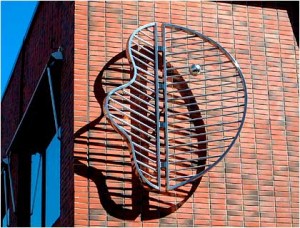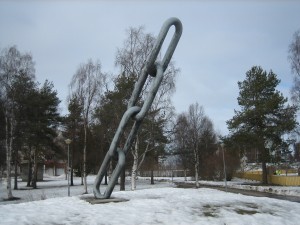 The Brothers in Arms Chain -statue is a memorial to the Swedish and Norwegian volunteers, who fought for Finland during the Winter War in 1939-1940. The statue is made by the Swedish sculptor Oscar Reutersvärd (1915-2002) in 1964, and stands in the Park on Pohjolankatu in Rovaniemi. It is amazing how strongly the enormous chain is put together and stands still.
The Brothers in Arms Chain -statue is a memorial to the Swedish and Norwegian volunteers, who fought for Finland during the Winter War in 1939-1940. The statue is made by the Swedish sculptor Oscar Reutersvärd (1915-2002) in 1964, and stands in the Park on Pohjolankatu in Rovaniemi. It is amazing how strongly the enormous chain is put together and stands still.
The “Monument to the Reconstruction of Lapland 1944-1955” is a symbol for how Rovaniemi has risen from the ashes after being burnt down by the German soldiers in 1944, to the town it is today; a young and dynamic city. The sculptor Kari Huhtamo was born in 1943 in Rovaniemi. He has made more than 40 public works all over Finland and is also well-known abroad and even in Russia. This statue is made of clear stainless steel in 1977. At the time the statue was brought to Rovaniemi the inhabitants were a bit critical to it and it got a nick-name: the pigeons’ radar. I think this piece of art is beautiful and you can find it near the railway station in the slope between Ratakatu and Pohjolankatu, where it gives a very nice welcoming to the arriving guests of Rovaniemi.
Kati Huhtamo has also made the smaller work “Antinkulma” on the wall of Rovakatu 32. This he made in 1986. I have always thought this piece of art reminds me of a human face profile. But the explanation is that it is a symbol of abstract and non-material reality.
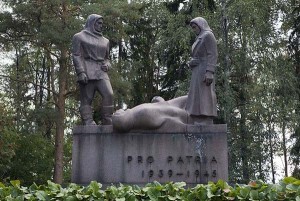 An artist with more realistic looking works is the Finnish sculptor Wäinö Aaltonen (1894-1966). He has used granite in many of his works. As Wäinö Aaltonen himself has experienced the wars WWI and WWII himself they have influenced him to do memorials of the wars. After the Peace as many other sculptors of Finland he got a lot of orders to make memorials to public places all over the country. On the cemetery of Rovaniemi stands his statue Pro Patria as a symbol for the 604 fallen soldiers from Rovaniemi in the war 1939-1945.
An artist with more realistic looking works is the Finnish sculptor Wäinö Aaltonen (1894-1966). He has used granite in many of his works. As Wäinö Aaltonen himself has experienced the wars WWI and WWII himself they have influenced him to do memorials of the wars. After the Peace as many other sculptors of Finland he got a lot of orders to make memorials to public places all over the country. On the cemetery of Rovaniemi stands his statue Pro Patria as a symbol for the 604 fallen soldiers from Rovaniemi in the war 1939-1945.
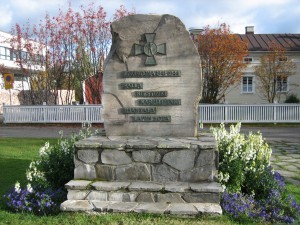
The graphic designer and heraldic Olaf Eriksson (1911-1987) has designed the memorial of the “6th Division” during the war in 1941. The memorial of quartzite stone was risen 1981 at Valtakatu in Rovaniemi.
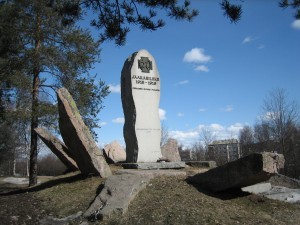 A memorial of the peace in 1917 is the stone work “Broken Irons” (my own translation) of Ensio Seppänen (1924-2008). He was born in Kemijärvi in Lapland. The work from 1981 symbolizes the obtained freedom from Russia and is a memorial of the Jaeger movement in Finland at that time. The stone in the middle symbolizes the independent Finland rising and separating from Russian dominion. It stands in Jääkäripuisto in Rovaniemi at Lapinkävijäntie.
A memorial of the peace in 1917 is the stone work “Broken Irons” (my own translation) of Ensio Seppänen (1924-2008). He was born in Kemijärvi in Lapland. The work from 1981 symbolizes the obtained freedom from Russia and is a memorial of the Jaeger movement in Finland at that time. The stone in the middle symbolizes the independent Finland rising and separating from Russian dominion. It stands in Jääkäripuisto in Rovaniemi at Lapinkävijäntie.
In my next chapter – part 3 – I will tell you about the female sculptors who have their works standing in Rovaniemi and also about the pieces of art at the Administrative Center of Rovaniemi.


